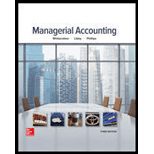
Managerial Accounting
3rd Edition
ISBN: 9780077826482
Author: Stacey M Whitecotton Associate Professor, Robert Libby, Fred Phillips Associate Professor
Publisher: McGraw-Hill Education
expand_more
expand_more
format_list_bulleted
Question
Chapter 10, Problem 3.1GAP
To determine
Concept introduction:
Return on investment is a profitability ratio that represents the percentage return on the investment made. It is calculated by dividing the Net Income by the Average total assets. The formulas to calculate the ROI are as follows:
To calculate:
The return on investment (ROI) for each division
Expert Solution & Answer
Want to see the full answer?
Check out a sample textbook solution
Students have asked these similar questions
What is the net income?
do not use ai solution General accounting question
Solve this questions
Chapter 10 Solutions
Managerial Accounting
Ch. 10 - Explain how centralized and decentralized...Ch. 10 - Why does decentralization create the need for...Ch. 10 - What is the controllability principle and why is...Ch. 10 - Prob. 4QCh. 10 - Prob. 5QCh. 10 - Prob. 6QCh. 10 - Prob. 7QCh. 10 - Prob. 8QCh. 10 - Return on investment may be separated into two...Ch. 10 - Prob. 10Q
Ch. 10 - Prob. 11QCh. 10 - Prob. 12QCh. 10 - Prob. 13QCh. 10 - Prob. 14QCh. 10 - Prob. 15QCh. 10 - Prob. 16QCh. 10 - Prob. 17QCh. 10 - Why must a company consider its incentive and...Ch. 10 - Prob. 19QCh. 10 - Prob. 20QCh. 10 - Prob. 21QCh. 10 - Prob. 22QCh. 10 - Prob. 23QCh. 10 - Prob. 24QCh. 10 - Prob. 25QCh. 10 - What are negotiated transfer prices? Explain two...Ch. 10 - Sally Thorne is a profit center manager for ABC...Ch. 10 - Prob. 2MCCh. 10 - Which of the following statements is true? a. A...Ch. 10 - Prob. 4MCCh. 10 - Prob. 5MCCh. 10 - Prob. 6MCCh. 10 - Prob. 7MCCh. 10 - Prob. 8MCCh. 10 - Which of the following is not a component of the...Ch. 10 - Prob. 10MCCh. 10 - Using Terms to Complete Sentences about...Ch. 10 - Prob. 2MECh. 10 - Prob. 3MECh. 10 - Applying Balanced Scorecard to Real World Company...Ch. 10 - Applying Balanced Scorecard to Online Company...Ch. 10 - Prob. 6MECh. 10 - Prob. 7MECh. 10 - Prob. 8MECh. 10 - Prob. 9MECh. 10 - Prob. 10MECh. 10 - Prob. 11MECh. 10 - Prob. 12MECh. 10 - Prob. 13MECh. 10 - Prob. 2ECh. 10 - Prob. 3ECh. 10 - Prob. 4ECh. 10 - Calculating Return on Investment, Residual Income,...Ch. 10 - Prob. 6ECh. 10 - Evaluating Managerial Performance Using Return on...Ch. 10 - Evaluating Managerial Performance Using Return on...Ch. 10 - Prob. 9ECh. 10 - Determining the Impact of Various Transactions on...Ch. 10 - Determining Different Types of Responsibility...Ch. 10 - Prob. 14ECh. 10 - Prob. 15ECh. 10 - Prob. 16ECh. 10 - Matching Measures of Performance with the Correct...Ch. 10 - Determining Minimum, Maximum, Negotiated Transfer...Ch. 10 - Prob. 19ECh. 10 - Prob. 20ECh. 10 - Calculating Return on Investment, Residual Income,...Ch. 10 - Prob. 1.2GAPCh. 10 - Calculating Unknowns, Predicting Relationship...Ch. 10 - Calculating Unknowns, Predicting Relationship...Ch. 10 - Prob. 2.3GAPCh. 10 - Prob. 2.4GAPCh. 10 - Prob. 2.5GAPCh. 10 - Prob. 2.6GAPCh. 10 - Prob. 3.1GAPCh. 10 - Prob. 3.2GAPCh. 10 - Prob. 3.3GAPCh. 10 - Prob. 3.4GAPCh. 10 - Prob. 3.5GAPCh. 10 - Prob. 3.6GAPCh. 10 - Prob. 4.1GAPCh. 10 - Prob. 4.2GAPCh. 10 - Prob. 4.3GAPCh. 10 - Prob. 4.4GAPCh. 10 - Prob. 4.5GAPCh. 10 - Prob. 5.1GAPCh. 10 - Prob. 5.2GAPCh. 10 - Prob. 5.3GAPCh. 10 - Prob. 5.4GAPCh. 10 - Prob. 6GAPCh. 10 - Prob. 1.1GBPCh. 10 - Prob. 1.2GBPCh. 10 - Prob. 2.1GBPCh. 10 - Prob. 2.2GBPCh. 10 - Prob. 2.3GBPCh. 10 - Prob. 2.4GBPCh. 10 - Prob. 2.5GBPCh. 10 - Prob. 2.6GBPCh. 10 - Prob. 3.1GBPCh. 10 - Prob. 3.2GBPCh. 10 - Prob. 3.3GBPCh. 10 - Prob. 3.4GBPCh. 10 - Prob. 3.5GBPCh. 10 - Prob. 3.6GBPCh. 10 - Prob. 4.1GBPCh. 10 - Prob. 4.2GBPCh. 10 - Prob. 4.3GBPCh. 10 - Prob. 4.4GBPCh. 10 - Prob. 4.5GBPCh. 10 - Prob. 5.1GBPCh. 10 - Prob. 5.2GBPCh. 10 - Prob. 5.3GBPCh. 10 - Prob. 5.4GBPCh. 10 - Prob. 6GBP
Knowledge Booster
Learn more about
Need a deep-dive on the concept behind this application? Look no further. Learn more about this topic, accounting and related others by exploring similar questions and additional content below.Similar questions
arrow_back_ios
SEE MORE QUESTIONS
arrow_forward_ios
Recommended textbooks for you
 Cornerstones of Cost Management (Cornerstones Ser...AccountingISBN:9781305970663Author:Don R. Hansen, Maryanne M. MowenPublisher:Cengage Learning
Cornerstones of Cost Management (Cornerstones Ser...AccountingISBN:9781305970663Author:Don R. Hansen, Maryanne M. MowenPublisher:Cengage Learning Managerial AccountingAccountingISBN:9781337912020Author:Carl Warren, Ph.d. Cma William B. TaylerPublisher:South-Western College Pub
Managerial AccountingAccountingISBN:9781337912020Author:Carl Warren, Ph.d. Cma William B. TaylerPublisher:South-Western College Pub Financial And Managerial AccountingAccountingISBN:9781337902663Author:WARREN, Carl S.Publisher:Cengage Learning,
Financial And Managerial AccountingAccountingISBN:9781337902663Author:WARREN, Carl S.Publisher:Cengage Learning, Managerial Accounting: The Cornerstone of Busines...AccountingISBN:9781337115773Author:Maryanne M. Mowen, Don R. Hansen, Dan L. HeitgerPublisher:Cengage Learning
Managerial Accounting: The Cornerstone of Busines...AccountingISBN:9781337115773Author:Maryanne M. Mowen, Don R. Hansen, Dan L. HeitgerPublisher:Cengage Learning

Cornerstones of Cost Management (Cornerstones Ser...
Accounting
ISBN:9781305970663
Author:Don R. Hansen, Maryanne M. Mowen
Publisher:Cengage Learning

Managerial Accounting
Accounting
ISBN:9781337912020
Author:Carl Warren, Ph.d. Cma William B. Tayler
Publisher:South-Western College Pub

Financial And Managerial Accounting
Accounting
ISBN:9781337902663
Author:WARREN, Carl S.
Publisher:Cengage Learning,

Managerial Accounting: The Cornerstone of Busines...
Accounting
ISBN:9781337115773
Author:Maryanne M. Mowen, Don R. Hansen, Dan L. Heitger
Publisher:Cengage Learning
Introduction to Divisional performance measurement - ACCA Performance Management (PM); Author: OpenTuition;https://www.youtube.com/watch?v=pk8Mzoqr4VA;License: Standard Youtube License